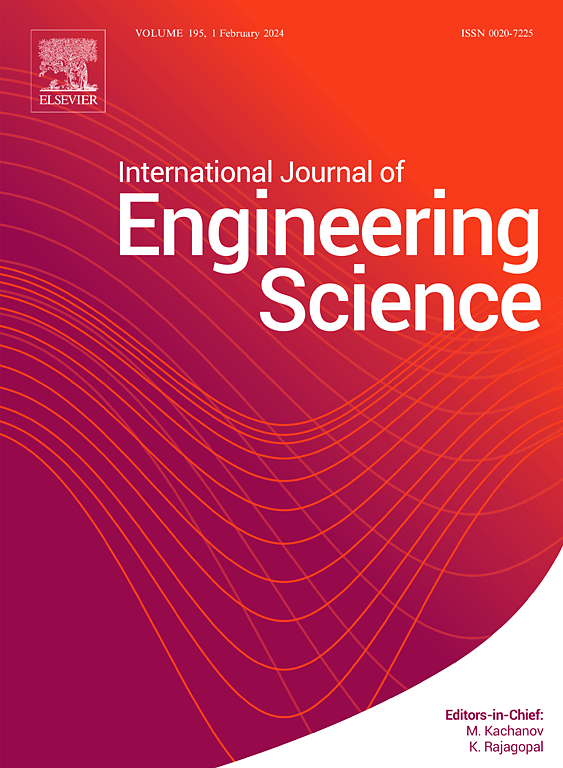孔隙弹性通道中压力驱动流体的弹性水动力不稳定性
IF 5.7
1区 工程技术
Q1 ENGINEERING, MULTIDISCIPLINARY
International Journal of Engineering Science
Pub Date : 2025-09-15
DOI:10.1016/j.ijengsci.2025.104379
引用次数: 0
摘要
本文对夹在两个不透水刚性壁面之间的饱和孔弹性通道进行了压力驱动流动的线性稳定性分析。混合理论用于描述间隙流体和弹性固体基质的动力学。利用伪谱法求解得到的特征值问题。在没有孔隙弹性固体基体的情况下,所考虑的流动可以简化为经典的平面泊泽维尔流动,线性稳定性分析预测其临界雷诺数Rec=5772。然而,本研究预测,由于固体基体的可变形性,所考虑的流动的Rec可能低至5。进一步分析表明存在三种新的不稳定模态。对于低Re, I型主导不稳定性,而在高Re时,III型主导不稳定性,其特征标度为Γc ~ 1/Re,其中Γc是固体基体变形能力的度量。发现预测的不稳定性的驱动机制是由于压力扰动引起的流体与固体之间的耦合。线性化Navier-Stokes方程中基态速度梯度与法向速度扰动之间通过对流项的能量交换对引入不稳定模态的压力扰动起支持作用。本文章由计算机程序翻译,如有差异,请以英文原文为准。
Elastohydrodynamic instabilities in pressure-driven flow through a poroelastic channel
The linear stability analysis of a pressure-driven flow through a saturated poroelastic channel sandwiched between two impermeable rigid walls is carried out in the present study. Mixture theory is employed to describe the dynamics of the interstitial fluid and elastic solid matrix. The resulting eigenvalue problem is solved using the pseudo-spectral method. Without the poroelastic solid matrix, the flow under consideration reduces to the classical plane Poiseuille flow for which the linear stability analysis predicts critical Reynolds number, . However, the present study, predicts that could be as low as 5 for the flow under consideration owing to the deformability of the solid matrix. Further analysis reveals the existence of three new modes of instability. For low , mode I dominates the instability, while at high , mode III dominates the instability with characteristic scaling where is a measure of the deformability of the solid matrix. The driving mechanism of the predicted instability is found to be the coupling between the fluid and solid due to the pressure perturbation. The energy exchange between the base state velocity gradient and normal velocity perturbation via the convection term in the linearised Navier–Stokes equation plays a supporting role to the pressure perturbations in introducing unstable modes.
求助全文
通过发布文献求助,成功后即可免费获取论文全文。
去求助
来源期刊

International Journal of Engineering Science
工程技术-工程:综合
CiteScore
11.80
自引率
16.70%
发文量
86
审稿时长
45 days
期刊介绍:
The International Journal of Engineering Science is not limited to a specific aspect of science and engineering but is instead devoted to a wide range of subfields in the engineering sciences. While it encourages a broad spectrum of contribution in the engineering sciences, its core interest lies in issues concerning material modeling and response. Articles of interdisciplinary nature are particularly welcome.
The primary goal of the new editors is to maintain high quality of publications. There will be a commitment to expediting the time taken for the publication of the papers. The articles that are sent for reviews will have names of the authors deleted with a view towards enhancing the objectivity and fairness of the review process.
Articles that are devoted to the purely mathematical aspects without a discussion of the physical implications of the results or the consideration of specific examples are discouraged. Articles concerning material science should not be limited merely to a description and recording of observations but should contain theoretical or quantitative discussion of the results.
 求助内容:
求助内容: 应助结果提醒方式:
应助结果提醒方式:


